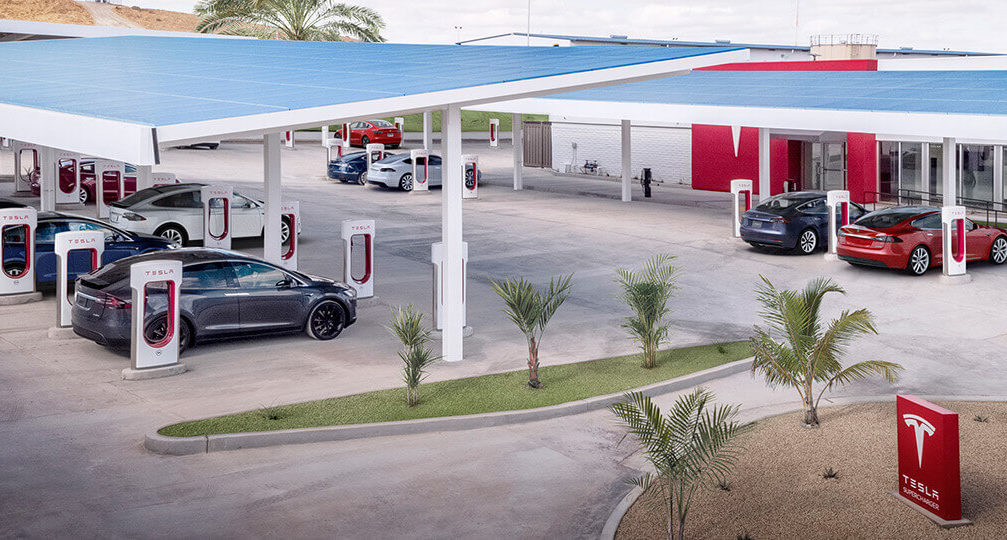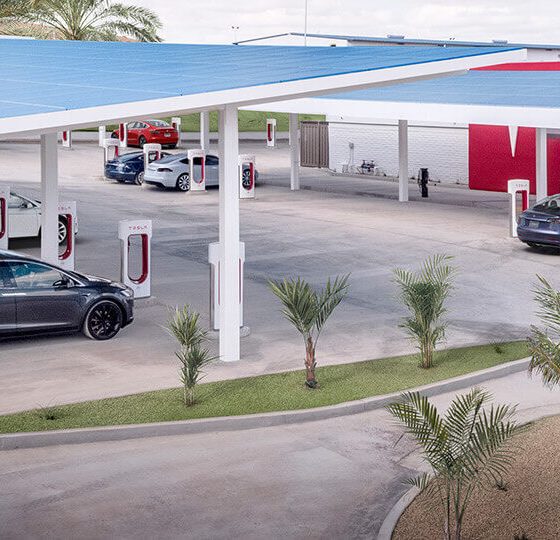Welcome to a FREE preview of our weekly exclusive! Each week our team goes ‘Beyond the News’ and handcrafts a special edition that includes our thoughts on the biggest stories, why it matters, and how it could impact the future.
You can receive this newsletter along with all of our other members-exclusive newsletters, become a premium member for just $3/month. Your support goes a long way for us behind the scenes! Thank you.
—
A couple of weeks ago, IONITY revealed their new “Halo” charger rated at 350 kW that’s supposed to charge EVs 220 miles in ten minutes at some point in the future. It sounds pretty great on the outset, and when claims of “more”, “faster”, and “better” are rewarded with headlines, there’s no wonder that this type of tech is being produced well before any electric cars can actually utilize it. Three cheers for progress, yeah?
I’m not so sure.
While I understand the push to make EV charging faster so drivers can have a one-to-one trade off with their gasoline fill up experience, is that what’s going to be in demand as battery-powered transportation takes off? There’s also the question of whether battery health is going to take a huge dive with that sort of charging. I’m probably a bit biased towards Elon Musk’s opinion on such things (Tesla is leading the battery revolution, after all), so when he says 350 kW is a battery killer, I believe him. Will the tech catch up? I don’t know. But, I’m more questioning whether it needs to.
There are some considerable differences and advantages that electric cars have over ICE cars, and I don’t just mean in the emissions sense. With an ICE vehicle, it’s not (realistically) possible to have a nozzle attached to your gas tank in your garage overnight while you sleep, enabling you to wake up to a full tank each morning. You can’t do that while you’re at work, either, nor while running errands. Swap “nozzle” for a charging cable and you can with an EV, though. I really think this is going to be the biggest distinction in our ICE-driven world today and the battery-driven one in the future. Fast charging is great while you need it, but someday we won’t need it. Will we ever need “Halo” charging?
There’s still some time yet before EV chargers are as ubiquitous as wall chargers (and I guess technically those can be EV chargers, too), but hey – if airports and coffee bars can finally catch up to laptop and smartphone needs (plugs everywhere!), so can entities with parking lots. Not to mention, all that happened as a team effort by the tech companies and the plug-providing businesses: Better batteries plus better access to electricity equals electronic happiness (and expansion) for the consumer.
I know there was a period of time when longer cables were phone companies’ answer to portable phone conversations before cordless phones came along, which I admittedly only know because I like classic movies and TV shows. To me, this is a bit of a metaphor for what’s going on with EV charging. “Halo” type chargers are kind of the equivalent to longer telephone cords, and history shows that more of one thing isn’t always better.
The cordless phones are kind of a good metaphor, too. I remember (first hand) how long it took before static issues were eliminated. “Hold on, let me switch to the other phone because I’m too far from the base,” was a frequent conversation comment, and then multi-base systems were offered to solve that one, too. I see the static as the issue of long charging times and the phone base in every room as the faster and faster chargers. We’ve kind of foregone home phones altogether now thanks to cell phones, but to me that’s kind of like imagining an EV plug in every parking spot regardless of whether you’re a homeowner or a renter or a parking garage frequenter.
Once upon a time, cell phone batteries were huge, heavy, and held very little charge. We still complain about them since there are more and more power-hungry features added, but do we opt for a rotary phone over the issue? Nah. We keep chargers in our cars, in the wall at work, in our bags, and so forth. I think ultimately we’ll go in that direction with EVs rather than the hypercharger one, and it will change the landscape. Literally.

Lifestyle
Tesla Model S Plaid battles China’s 1500 hp monster Nurburgring monster, with surprising results
There is just something about Tesla’s tuning and refinement that makes raw specs seem not as game-changing.

The Tesla Model S Plaid has been around for some time. Today, it is no longer the world’s quickest four-door electric sedan, nor is it the most powerful. As per a recent video from motoring YouTube channel Carwow, however, it seems like the Model S Plaid is still more than a match for some of its newer and more powerful rivals.
The monster from China
The Xiaomi SU7 Ultra is nothing short of a monster. Just like the Model S Plaid, it features three motors. It also has 1,548 hp and 1,770 Nm of torque. It’s All Wheel Drive and weighs a hefty 2,360 kg. The vehicle, which costs just about the equivalent of £55,000, has been recorded setting an insane 7:04.957 at the Nurburgring, surpassing the previous record held by the Porsche Taycan Turbo GT.
For all intents and purposes, the Model S Plaid looked outgunned in Carwow’s test. The Model S Plaid is no slouch with its three motors that produce 1,020 hp and 1,420 Nm of torque. It’s also a bit lighter at 2,190 kg despite its larger size. However, as the Carwow host pointed out, the Model S Plaid holds a 7:25.231 record in the Nurburgring. Compared to the Xiaomi SU7 Ultra’s record, the Model S Plaid’s lap time is notably slower.
Real-world tests
As could be seen in Carwow’s drag races, however, Tesla’s tech wizardry with the Model S Plaid is still hard to beat. The two vehicles competed in nine races, and the older Model S Plaid actually beat its newer, more powerful counterpart from China several times. At one point in the race, the Xiaomi SU7 Ultra hit its power limit due to its battery’s temperature, but the Model S Plaid was still going strong.
The Model S Plaid was first teased five years ago, in September 2020 during Tesla’s Battery Day. Since then, cars like the Lucid Air Sapphire and the Xiaomi SU7 Ultra have been released, surpassing its specs. But just like the Model Y ended up being the better all-rounder compared to the BYD Sealion 7 and the MG IM6, there is just something about Tesla’s tuning and refinement that makes raw specs seem not as game-changing.
Check out Carwow’s Model S Plaid vs Xiaomi SU7 drag race video below.
Lifestyle
500-mile test proves why Tesla Model Y still humiliates rivals in Europe
On paper, the BYD Sealion 7 and MG IM6 promised standout capabilities against the Model Y.

BYD is seeing a lot of momentum in Europe, so much so that mainstream media has taken every opportunity to argue that the Chinese automaker has beaten Tesla in the region. But while BYD sales this year in Europe are rising and Tesla’s registrations remain challenged, the raw capabilities of vehicles like the Model Y are difficult to deny.
This was highlighted in a 500-mile challenge by What Car? magazine, which showed that the new Tesla Model Y is more efficient, cheaper to run, and more reliable than rivals like the BYD Sealion 7, and even the nearly 400 KW-charging MG IM6.
Range and charging promises
On paper, the BYD Sealion 7 and MG IM6 promised standout capabilities against the Model Y. The Sealion 7 had more estimated range and the IM6 promised significantly faster charging. When faced with real-world conditions, however, it was still the Model Y that proved superior.
During the 500-mile test, the BYD nearly failed to reach a charging stop, arriving with less range than its display projected, as noted in a CarUp report. MG fared better, but its charging speeds never reached its promised nearly-400 kW charging speed. Tesla’s Model Y, by comparison, managed energy calculations precisely and arrived at each stop without issue.
Tesla leads in areas that matter
Charging times from 25% to 80% showed that the MG was the fastest at 17 minutes, while Tesla and BYD were close at 28 and 29 minutes, respectively. Overall efficiency and cost told a different story, however. The Model Y consumed 19.4 kWh per 100 km, compared to 22.2 for MG and 23.9 for BYD. Over the full trip, Tesla’s charging costs totaled just £82 thanks to its supercharger network, far below BYD’s £130 and MG’s £119.
What Car? Magazine’s testers concluded that despite BYD’s rapid sales growth and the MG IM6’s seriously impressive charging speeds, Tesla remains the more compelling real-world choice. The Model Y just offers stability, efficiency, and a proven charging infrastructure through its Supercharging network. And as per the magazine’s hosts, the Model Y is even the cheapest car to own among the three that were tested.
Watch What Car? Magazine’s 500-mile test in the video below.
Lifestyle
Tesla Cybertruck slapped with world’s least intimidating ticket, and it’s pure cringe
One cannot help but cringe and feel second-hand embarrassment at the idea of a person just driving around with a stack of these babies.

A Cybertruck parked at Stanford Shopping Center in California was recently hit with what might be the most try-hard piece of paper ever slipped under a wiper blade: a “fake citation” accusing the driver of supporting a “fascist car.”
The note, shared on X by Tesla staff program manager Ryan Torres, quickly made the rounds on X, where it quickly gained attention as an example of how not to protest.
The world’s least intimidating ticket
According to the citation, the supposed “violation” was “driving a fascist car.” The remedial action? Take the bus, call an Uber, or ride a bike. The note also dubbed Elon Musk a “chainsaw-wielding Nazi billionaire.” Now, protests against Tesla and Elon Musk have become commonplace this year, but one cannot help but cringe and feel second-hand embarrassment at the idea of a person just driving around with a stack of fake anti-Tesla/Musk citations.
Torres pointed out the irony himself in his post on X. Tesla currently employs over 140,000 Americans, and SpaceX has put the U.S. firmly back at the top of space technology. As Torres put it, maybe the person behind the world’s least intimidating ticket should “read a book on innovation before vandalizing” other people’s property.
Peak performative clownery
Not to mention that the fake ticket’s logic collapses under its own weight. EVs like the Cybertruck are literally designed to reduce emissions, not “destroy the economy.” If anything, Tesla has bolstered the United States’ economy by fueling jobs in engineering, manufacturing, and clean energy. It’s not the first time a Tesla has been the target of vandalism or politically charged notes, but this one stands out for sheer cringe value.
Torres summed it up neatly: “Peak clownery.” On that point, at least, the citation earns full marks. In a way, though, perhaps cringe fake tickets are not as bad as the literal firebombs that were being thrown at Tesla stores and cars earlier this year because some critics were gleefully misinformed about Elon Musk.










